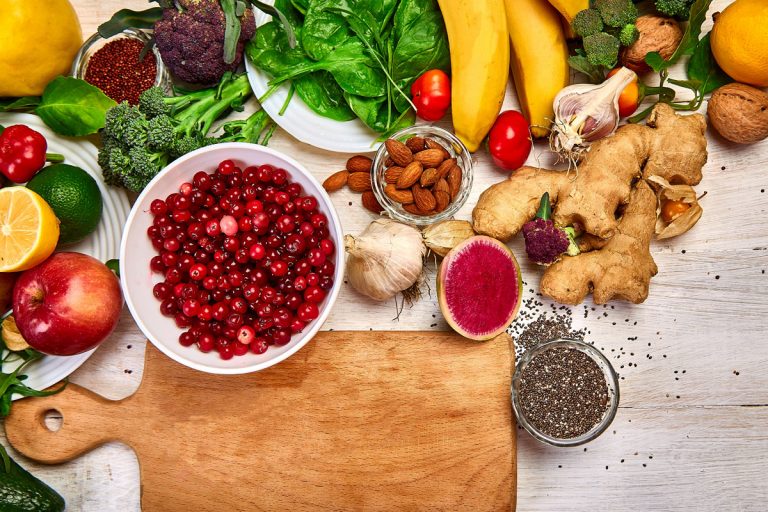Nutrition for kids is one of the most important aspects of their upbringing. A healthy diet provides the nutrients they need to grow, learn and play. Healthy eating behaviors can be developed at a young age. If your child eat healthy foods on a regular basis, then they are on the right track towards healthy eating. Though the first step to helping children with healthy eating is to make good food choices yourself.
Generally, children learn from their parents and will imitate what they see. You can set a great example by the way you eat, including making healthy foods choice for your own benefit, as well as for your kids. Healthy eating lifestyles at any age will benefit you and your child in the long run. Healthy foods are one of the most important factors for good health, especially during childhood and adolescence when growth and development occurs.
Nutritional needs for kids are relatively different from that of adults and should be catered to accordingly. The primary considerations of a proper diet for children are adequate calorie intake, proper nutrition and a balanced diet. Healthy eating habits are not difficult to inculcate in kids. You can help your child lead a healthy lifestyle by following simple guidelines for what they should eat. This blog post will provide you with a basic nutrition guide for kids so that you can make informed decisions about what they eat.
How much nutrition child needs?

As well as the nutrients needed by kids to stay healthy include proteins, carbohydrates, fats, vitamins and minerals. These nutrients are found in food. By eating a variety of foods from each of these groups, your child gets all the essential nutrients he or she needs for proper growth.
Although a child’s diet is an important factor for proper growth. It is of even greater importance that he or she receives an adequate amount of physical activity on a daily basis. Unlike adults, children are still growing, and they need the right amounts of nutrients to grow up healthy and strong. The Dietary Guidelines for Americans offers this advice on daily calorie intake
- A girl child between 4 and 8 years should eat about 1,200 calories each day.
- A boy child between 4 and 8 years should eat about 1,400 calories each day.
- A girl child between 9 and 13 years old should eat about 1,600 calories each day.
- A boy child between 9 and 13 years old should eat about 1, 800 calories each day.
- A girl child between 14 to 18 years should eat about 1,800 calories each day.
- A boy child between 14 to 18 years should eat about 2,000 calories each day.
Therefore, according to the Dietary Guidelines for Americans, healthy diets consists of these components 45% – 65% from carbohydrate sources such as whole wheat bread, cereals, pasta and starchy vegetables like potatoes, yams and corn; 10% – 35% from protein sources such as meat, poultry fish nuts oils and legumes; 20% or fewer calories from fat; 3 cups of a fruit juice and vegetables each day.
Moreover, to provide essential fatty acids in a child’s diet, the Guidelines also suggests that a child consumes fatty fish such as salmon, mackerel and herring once a week. Plant-based sources of omega 3 fatty acids include soybeans and canola oil. Including healthy fats in the diet plan also is important. For example, a child needs about 1 tsp of fat per every 2 cups of food. This is because kids need fatty acids to help them absorb vitamins and avoid consuming too much sugar. There are some minor differences in these guidelines between genders but all are focused on a eat healthier diet plan.
What is a healthy balanced diet for kids?

Furthermore, a healthy balanced diet for kids contains healthy foods to help them maintain good health. A balanced diet is the combination of foods that supply all the nutrients needed for growth and development. To make a child to eat healthy foods a parent should be a good role model. Below are some foods lists you should consider feeding your kids and they are
1. Whole grains
Whole grains form the base of a nutritious diet. They are rich in fiber and other nutrients needed for optimum health. Children should be encouraged to eat whole grains for breakfast, lunch, and dinner. However, they can be given between meals too. Examples include oatmeal, brown rice, whole wheat bread, pasta or tortillas made with whole-grain flour or cornmeal. For a healthy weight, a child’s doctor said about the refined grains that they are very low in fiber and nutrient-dense foods. They may contribute calories, but little or no nutrients that help children build strong bones, muscles and teeth.
2. Low-fat dairy products
Low-fat dairy product forms an important part of a well-balanced, nutritious diet. These products contain protein, calcium and Vitamin D that give the body a boost to fight against diseases. The body uses protein from dairy products to build strong muscles, bones and teeth. Calcium is also used by the body for many things such as building bones and regulating the heart’s rhythm. Vitamin D helps the body use calcium, which ultimately helps promote strong bones. Milk, yogurt and cheese are examples of low-fat dairy products that kids should be given regularly to keep them healthy and strong.
3. Eat nutrient-dense foods
Vegetables are nutrient-dense foods that should form an important part of a child’s diet. Examples of nutritious vegetables include dark green, red and orange vegetables like broccoli, carrots, sweet potatoes and spinach. However, they can be prepared in different ways such as steaming instead of boiling to retain their nutritional value. Colorful vegetables enhance the color of meals and make them more appetising. They are rich in many vitamins like vitamin A, which is needed for healthy skin, eyesight and cell division; Vitamin C that helps boost the immune system; potassium that regulates blood pressure fiber that helps with digestion.
4. Avoid sugary drinks

If your child drinks juice that is 100% pure, plant-based juice is healthy. However, do not give your child sugar-sweetened beverages like soda and fruit drinks because they contain too much added sugar in the form of sucrose or high fructose corn syrup which can lead to excess calorie intake. They also contain zero nutrients that will help muscle development or protect against diseases.
5. Canned Frozen or dried
Fruits are always available in different forms. You can give your kid canned fruit or frozen fruit. However, you must make sure that they do not contain added sugar or sodium before buying them for your kids. Instead of giving your kid processed foods, buy whole fruits because they contain more vitamins and minerals than their processed counterparts. You can also give your kid dried fruit for a healthy snack. However, do not give your child fruits that have added sugar or sodium before buying them for the little one.
6. Dark green vegetable and nut oils
Dark green vegetables have a large number of healthy minerals and phytochemicals. Vegetables also contain zero cholesterol, sodium or saturated fats. You should give your child dark green vegetables because they are nutritious and delicious. In addition, you can add canola oil to your kid’s daily meals because it is rich in alpha-linolenic acid (ALA). However, you should try to avoid the consumption of hydrogenated oils. Sometimes fortified soy beverages can be an excellent source of minerals and vitamins for your child.
7. Brown or wild rice
It is important to note that whole grains are rich in fiber, iron and B vitamins. There is also some evidence that people who eat more whole grains have a lower risk of developing Type 2 diabetes or heart disease or even experience weight gain when they follow a healthy diet plan. You should give your child brown rice because it contains nutrients in high amounts. For your child healthy meals, you should avoid giving them polished, white rice because it has no nutrients. Brown rice is naturally present in the husk which is rich in fiber, iron and B vitamins. You can easily give your child brown rice because it contains nutrients such as magnesium, manganese and thiamin in high amounts.
8. Fruits juice
Fruits juice are healthy for the kids. However, you must know that fruit juices contain high amounts of naturally occurring sugars. Therefore, you should limit the amount because it may cause weight gain in children who do not spend enough time being active or just have an extra portion of their diet that is well-balanced. If your kids drink fat-free or low-fat fruit juice then make sure they do not contain added sugar. As to limit juice intake as much as possible and replace it with water. As well as saturated and trans fats from foods, you should try to avoid consuming anything that comes from a can. This is because they contain high amounts of sodium and empty calories. There are some healthy food choices for kids including fatty fish such as salmon which contains omega-3 fatty acids which help with brain development and function.
The Conclusion
As parents, it is our responsibility to make sure that the kids are eating healthy. We all know how important nutrition is for growing children. The guidelines for a healthy diet are fairly straightforward. A well-balanced, nutritious diet can help children grow and develop optimally. It also helps control blood sugar levels, maintain weight, and prevent chronic diseases later in life. Children should be offered three meals per day with snacks as needed to avoid hunger or overeating at mealtimes. There is some individual variability on what constitutes an appropriate intake of calories depending on the child’s age, sex, activity level and other factors such as height or weight that may need to be taken into account when considering how many calories they require each day. If you have any queries regarding the context then feel free to contact us through a comment below.











